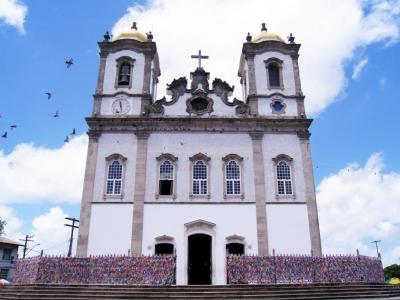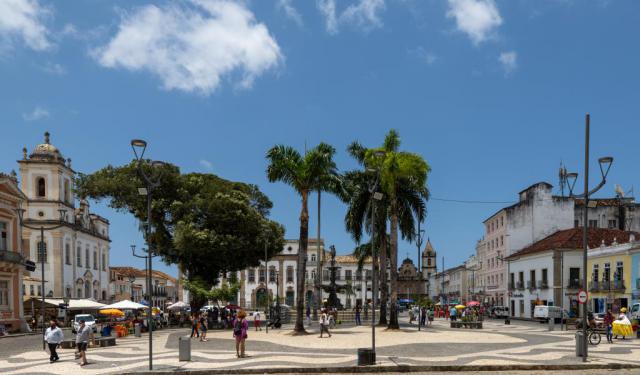
Church of Nosso Senhor do Bonfim, Salvador
The Church of Our Lord of Bonfim (Portuguese: Igreja de Nosso Senhor do Bonfim) is the most famous of the Catholic churches of Salvador. It was built in the 18th century on the only line of hills in the Itapagipe Peninsula, in the lower town of Salvador.
The church is the subject of intense religious devotion by the people of Salvador and is the site of a famous celebration held every year in January, the Festa do Senhor do Bonfim. The church is the Cathedral of the Roman Catholic Diocese of Bonfim. The church is noted for the Festa do Bonfim ("Feast of Bonfim"), held annually the second Thursday after Three Kings Day. The festival combines elements of both Catholicism and Candomblé. It was listed as a historic structure by the National Historic and Artistic Heritage Institute in 1938.
The Church of Nosso Senhor do Bonfim is constructed of brick and stone masonry. The façade of the church is two-dimensional, with a central body flanked by two towers. The windows and elaborate volutes of the gable of the pediment of the façade are in the Rococo style. The lower parts of the façade were covered by industrial Portuguese azulejo tiles in 1873. They are white with a yellow tint and were designed to resemble those of the Church of Saint Francis in the Historic Center of Salvador. The church has two bell towers; they were crowned with bulbous roofs at the end of the 19th century.
The interior decoration of the church was finished in the 19th century, and consists of a rich archive of painting, azulejos, gilded woodcarvings, and furniture. The nave has a single aisle. The church has six side altars; two on each of the lateral walls and two at the front of the nave. The Neoclassical main altarpiece, which has the form of a baldachin with a cupola sustained by volutes, was carved by the master sculptor Antônio Joaquim dos Santos between 1813 and 1814; he is likely also responsible for its design.
The side altars have paintings by José Teófilo de Jesus (ca. 1758–1847) at center in place of the gilded wooden images of saints found in other churches of Bahia. The interior of the church has a great number of azulejos. There are 28 large-scale azulejo panels on the lateral walls of the church depicting the life of Christ. They were painted by Tomáz do Carmo in Lisbon in 1855.
The Church of Nosso Senhor do Bonfim was listed as a historic structure by the National Institute of Historic and Artistic Heritage in 1938.
The church is the subject of intense religious devotion by the people of Salvador and is the site of a famous celebration held every year in January, the Festa do Senhor do Bonfim. The church is the Cathedral of the Roman Catholic Diocese of Bonfim. The church is noted for the Festa do Bonfim ("Feast of Bonfim"), held annually the second Thursday after Three Kings Day. The festival combines elements of both Catholicism and Candomblé. It was listed as a historic structure by the National Historic and Artistic Heritage Institute in 1938.
The Church of Nosso Senhor do Bonfim is constructed of brick and stone masonry. The façade of the church is two-dimensional, with a central body flanked by two towers. The windows and elaborate volutes of the gable of the pediment of the façade are in the Rococo style. The lower parts of the façade were covered by industrial Portuguese azulejo tiles in 1873. They are white with a yellow tint and were designed to resemble those of the Church of Saint Francis in the Historic Center of Salvador. The church has two bell towers; they were crowned with bulbous roofs at the end of the 19th century.
The interior decoration of the church was finished in the 19th century, and consists of a rich archive of painting, azulejos, gilded woodcarvings, and furniture. The nave has a single aisle. The church has six side altars; two on each of the lateral walls and two at the front of the nave. The Neoclassical main altarpiece, which has the form of a baldachin with a cupola sustained by volutes, was carved by the master sculptor Antônio Joaquim dos Santos between 1813 and 1814; he is likely also responsible for its design.
The side altars have paintings by José Teófilo de Jesus (ca. 1758–1847) at center in place of the gilded wooden images of saints found in other churches of Bahia. The interior of the church has a great number of azulejos. There are 28 large-scale azulejo panels on the lateral walls of the church depicting the life of Christ. They were painted by Tomáz do Carmo in Lisbon in 1855.
The Church of Nosso Senhor do Bonfim was listed as a historic structure by the National Institute of Historic and Artistic Heritage in 1938.
Sight description based on Wikipedia.
Want to visit this sight? Check out these Self-Guided Walking Tours in Salvador. Alternatively, you can download the mobile app "GPSmyCity: Walks in 1K+ Cities" from Apple App Store or Google Play Store. The app turns your mobile device to a personal tour guide and it works offline, so no data plan is needed when traveling abroad.
Church of Nosso Senhor do Bonfim on Map
Sight Name: Church of Nosso Senhor do Bonfim
Sight Location: Salvador, Brazil (See walking tours in Salvador)
Sight Type: Attraction/Landmark
Sight Location: Salvador, Brazil (See walking tours in Salvador)
Sight Type: Attraction/Landmark
Walking Tours in Salvador, Brazil
Create Your Own Walk in Salvador
Creating your own self-guided walk in Salvador is easy and fun. Choose the city attractions that you want to see and a walk route map will be created just for you. You can even set your hotel as the start point of the walk.
Salvador Introduction Walking Tour
Salvador is a coastal city in Brazil. Founded in 1548, it is the country's former capital and serves as the current capital of the state of Bahia. It is one of the oldest planned cities in the Americas.
Due to its location, early Europeans turned Salvador into an important trade route for slavery. Of the nearly 5 million enslaved people who were imported to Brazil, about 1.3 million were... view more
Tour Duration: 1 Hour(s)
Travel Distance: 1.6 Km or 1 Miles
Due to its location, early Europeans turned Salvador into an important trade route for slavery. Of the nearly 5 million enslaved people who were imported to Brazil, about 1.3 million were... view more
Tour Duration: 1 Hour(s)
Travel Distance: 1.6 Km or 1 Miles
Salvador's Historical Churches Tour
In Salvador, Brazil, there are quite a few churches emblematic of its cultural and religious heritage. The city's historic district contains so many old Catholic temples that some even joke that you can have a different church to visit there every day of the year. However, if you don't have a whole year to spend in Salvador but still want to make the most of your time in terms of... view more
Tour Duration: 1 Hour(s)
Travel Distance: 2.1 Km or 1.3 Miles
Tour Duration: 1 Hour(s)
Travel Distance: 2.1 Km or 1.3 Miles


